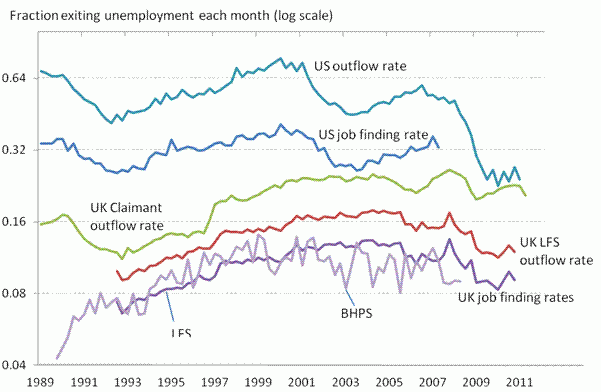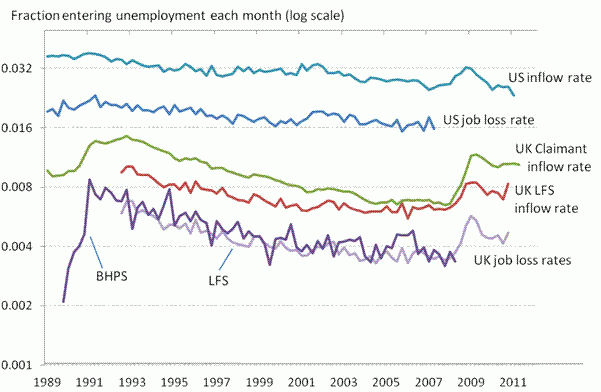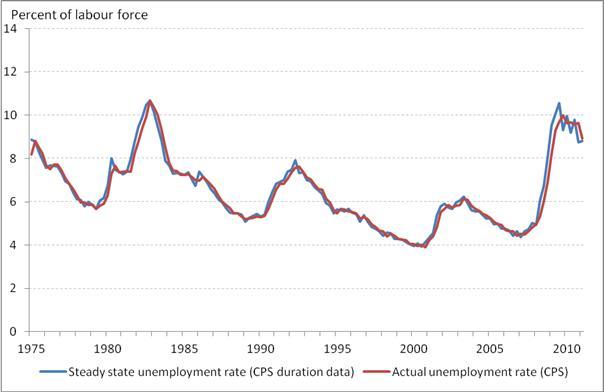The labour market is in a continual state of flux. Workers are hired, fired, joining the labour force and leaving the labour force. The balance of these flows determines the unemployment rate. In the US, research suggests that job finding is most influential in driving unemployment changes (Shimer 2007), although separation from jobs also plays a role at the start of recessions (Barnichon 2009, Elsby Michaels and Solon 2009; Fujita and Ramey 2009). But the US labour market stands out as different from other countries in its high level of turnover (Elsby et al. 2008). This raises the question: Do US findings hold for countries with lower transition rates?
UK job finding slower, but less volatile, than US
In the UK, job finding rates are typically much lower than in the US. One in two unemployed workers in the US remained unemployed for less than a month, on average over the last 22 years, whereas only about one in seven left unemployment that quickly in the UK. The faster US job finding and overall unemployment exit rates are a striking feature of Figure 1.1 In both countries, around two-thirds of unemployment exits are to employment; the remainder leave the labour force.
Figure 1. Unemployment outflow rates
The UK Labour Force Survey confirms that from the early 1990s the UK enjoyed a golden period of around 15 years of steadily improving average outflow rates, missing the downturn experienced by the US in the early 2000s. This was driven by faster job finding, as shown also by British Household Panel Survey data, demonstrating for the UK the same close cyclical correspondence of total exit and job finding rates documented for the US by Shimer (2007).2
The much higher levels and greater procyclicality of US job finding and overall unemployment exit rates, compared to the UK, are evident in Figure 1. Figure 1 also demonstrates a very striking contrast between US and UK labour markets in the 2008-09 recession. That is, the US outflow rate halved, whereas the UK rate fell by only a quarter. Put another way, the recession doubled average US unemployment duration, but only increased UK duration by one-third.
UK rates of job loss also lower than the US – and by more
UK job loss rates are also lower than US rates (see Figure 2). Indeed, the US-UK differential is bigger in terms of job loss, with US job loss and overall inflow rates being historically over four-and-a-half times as high as UK rates, whereas US job finding and overall unemployment outflow rates are about three times faster than in the UK. In both countries, job loss accounts for around 60% of those who enter unemployment; the remainder were previously not participating in the labour market.
Figure 2. Unemployment inflow rates
Which matters most for unemployment: Job finding or job loss?
The impression from Figures 1 and 2 is that US job finding rates vary more over the cycle than job loss rates, and are hence more likely to drive cyclical US unemployment movements.3 This fits with the research cited above, where formal analysis confirms that changes in job-finding rates are the main driver of US unemployment fluctuations. The policy implication is that measures to assist or incentivise the unemployed would be most useful in the US.
In the UK, the picture from Figures 1 and 2 is perhaps less clear. In the 2008-09 and early 1990s recessions there is evidence of both falls in unemployment exit rates and rises in unemployment entry rates. Does the UK’s different cyclical behaviour of labour market turnover – or its lower level of turnover rates – mean that policy priorities should differ from the US?
Low UK flow rates affect unemployment dynamics
Low UK flow rates mean that the empirical method used in much of the US research cited above will be inaccurate for the UK. In the US, actual unemployment almost immediately reaches its long-run level (the value that would be reached “in the steady state”, if flow rates stayed at current levels). This is because the speed of convergence to this steady state value is positively related to labour market fluidity. We have seen that US flow rates are very high, and Figure 3 demonstrates that they are so high that actual and steady state unemployment rates are almost identical – although the substantial decline in the job finding rate in 2008 is reflected in greater divergence of actual from steady state unemployment. So, much US research is based on steady-state unemployment, changes in which can be described by a simple formula depending only on current changes in flow rates.
Figure 3. US actual and steady state unemployment
Current flow movements account for nearly all actual unemployment changes in the US, but this is not true for the UK. The UK’s lower turnover rates mean that labour-market shocks persist for longer. Unemployment movements in the UK today reflect not only today’s shocks, but those from last period and, with increasingly less importance, those from periods much further back. Figure 4 shows the corresponding discrepancy between UK actual and steady state unemployment rates.
Figure 4. UK steady state and actual unemployment
Low convergence affects relative importance of inflows and outflows
A formal calculation based on my analysis in Smith (2011) reveals that current changes in inflow and outflow rates account for only around two-thirds of the current change in the UK unemployment rate. One-third of the change in UK unemployment is a response to past shocks. In Smith (2011) I have devised a method of decomposing unemployment that allows for this persistent effect of shocks (Elsby et al. 2008 describe a similar decomposition).
My decomposition of actual UK unemployment reveals that (current and past) movements in outflow and inflow rates are equally important in driving UK actual unemployment dynamics. In contrast, the US method of decomposing steady state unemployment would exaggerate the importance of inflow rate changes, attributing 60% of movements of the UK steady-state unemployment rate to them.4
In line with Figures 1 and 2, I show formally in Smith (2011) that job-finding and job-loss rate changes dominate flows into and out of the labour force in driving actual unemployment movements. As I document in Smith (2011), the relative importance of inflow and outflow rate changes does alter over time, with the improvement in job finding rates during the Great Moderation after the 1990s recession until the mid-2000s being primarily responsible for the substantial and sustained decline in the unemployment rate during that time, but rises in job loss rates having most responsibility for unemployment increases at the start of recessions.
Policy implications
These findings imply that – at least in the UK – policy could try to alleviate recessionary rises in job loss, as well as helping people back into work. UK policy over the last quarter-century has emphasised job finding. Benefit conditionality began with Restart in 1986, and similar emphasis continued with the introduction of Jobseeker’s Allowance in 1996, the merging of Employment Service and Benefit Agencies into Jobcentre Plus in 2002, the New Deal programmes from 1998 and the new Work Programme (see Bryson 2003 and Department of Work and Pensions 2011 for details).
The fact that US job finding rates are so much higher than UK rates indicates there is scope to further improve the speed of UK job-finding and reduce the average duration of unemployment. But the implication of my results – that alleviating job loss rises in recessions could be equally important in keeping unemployment low – suggests that the government could go further, through policies that encourage employers to hang on to workers. Germany’s “Kurzarbeit” policy, where the state subsidised jobs to allow reductions in hours but retention of jobs during the recent recession, is an example.
In terms of labour-market fluidity, the UK lies mid-way between high-turnover Anglo-Saxon and Nordic countries and “sclerotic” continental European countries (Elsby et al. 2008). So, what I have found to be an important factor in distinguishing the UK from the very-high-turnover US holds even more so in other low-turnover countries.
References
Barnichon, Regis (2009), “Vacancy Posting, Job Separation and Unemployment Fluctuations”, Federal Reserve Board Finance and Economics Discussion Series 2009-35.
Bryson, Alex (2003), “Permanent Revolution: The Case of Britain’s Welfare-to-Work Regime”, Benefits, 36(11):11-17.
Department of Work and Pensions (2011), Welfare Reform: Key Policy Documents.
Elsby, Michael WL, Bart Hobijn, and Aysegul Sahin (2008), “Unemployment Dynamics in the OECD”, NBER Working Paper 14617.
Elsby, Michael W L, Ryan Michaels, and Gary Solon (2009). “The Ins and Outs of Cyclical Unemployment”, American Economic Journal: Macroeconomics, 1(1):84-110.
Elsby, Michael W L and Jennifer C Smith (2010), “The Great Recession in the UK Labour Market: A Transatlantic Perspective”, National Institute Economic Review, 214(1):R26-R37.
Fujita, Shigeru and Garey Ramey (2009), “The Cyclicality of Separation and Job Finding Rates”, International Economic Review, 50(2):415-430.
Petrongolo, Barbara and Christopher A Pissarides (2008), “The Ins and Outs of European Unemployment”, American Economic Review, 98(2):256-262.
Shimer, Robert (2007), “Reassessing the Ins and Outs of Unemployment”, NBER Working Paper 13241.
Smith, Jennifer C (2011), “The Ins and Outs of UK Unemployment”, Economic Journal, 121(552):402-444.
1 Sources: US Bureau of Labor Statistics; Shimer (2007); UK Office for National Statistics: Quarterly Labour Force Survey and British Household Panel Survey micro data. I thank Robert Shimer for making his data available at http://sites.google.com/site/robertshimer/research/flows.
A log scale is used in Figures 1 and 2 because the dynamics of unemployment are most easily understood as a relationship between log, or percentage, changes in unemployment and flow rates. Values on the vertical axis are the levels of flow rates, which determine the ‘steady state’ unemployment rate that the actual unemployment rate would tend to in the absence of new shocks to inflow or outflow rates.
2 Figure 1 shows that the Claimant exit rate his relatively high, reflecting faster job finding by the subsample of UK unemployed who claim benefit and attend Jobcentre Plus or prior equivalents. This is likely in part to reflect different characteristics of claimants and non-claimant unemployed, but could also reflect the extra carrots and sticks associated with claiming benefit.
3 The 2008-09 US recession differs from the recessions of the early 1990s and 2000s in featuring a sizeable role for job loss (see Elsby and Smith 2010).
4 Petrongolo and Pissarides (2008) conduct a decomposition of the UK steady-state unemployment rate. Partly because they discard periods where actual and steady state unemployment deviate markedly, which as Figure 4 shows coincide with the start of recessions, when job loss dominates unemployment changes, they report an approximately equal importance of inflow and outflow rate changes.






